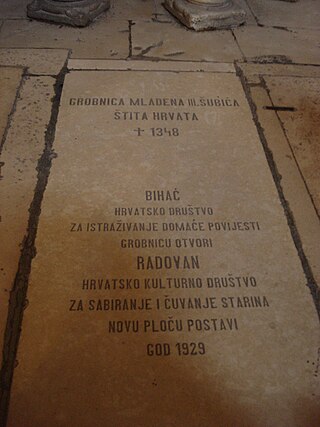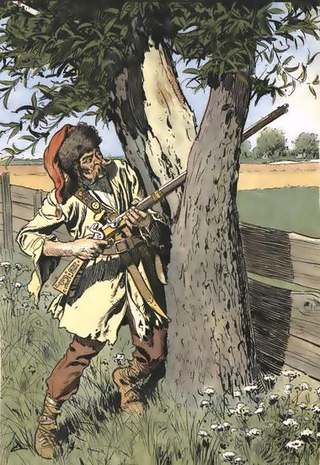Abjuration is the solemn repudiation, abandonment, or renunciation by or upon oath, often the renunciation of citizenship or some other right or privilege. The term comes from the Latin abjurare, "to forswear".

The Bosnian Church was a Christian church in medieval Bosnia and Herzegovina that was independent of and considered heretical by both the Catholic and the Eastern Orthodox hierarchies.

Zenica is a city in Bosnia and Herzegovina and an administrative and economic center of the Federation of Bosnia and Herzegovina's Zenica-Doboj Canton. It is located in the Bosna river valley, about 70 km (43 mi) north of Sarajevo. The city is known for its Ironworks Zenica factory but also as a significant university center. According to the 2013 census, the settlement of Zenica itself counts 70,553 citizens and the administrative area 110,663.

Kulin was the Ban of Bosnia from 1180 to 1204, first as a vassal of the Byzantine Empire and then of the Kingdom of Hungary, although his state was de facto independent. He was one of Bosnia's most prominent and notable historic rulers and had a great effect on the development of early Bosnian history. One of his most noteworthy diplomatic achievements is widely considered to have been the signing of the Charter of Ban Kulin, which encouraged trade and established peaceful relations between Dubrovnik and his realm of Bosnia. His son, Stephen Kulinić succeeded him as Bosnian Ban. Kulin founded the House of Kulinić.

Sinj is a town in the continental part of Split-Dalmatia County, Croatia. The town itself has a population of 11,478 and the population of the administrative municipality, which includes surrounding villages, is 24,826 (2011).

The Bosnia and Herzegovina national football team represents Bosnia and Herzegovina in international football competitions, and is governed by the Football Association of Bosnia and Herzegovina. Until 1992, Bosnian footballers played for Yugoslavia.

Stjepan, Ban of Bosnia was the third ruler of the banate of Bosnia recorded by name in written sources. He was in power sometime between 1204 and 1232. His rule was not popular, due to his Catholicism and allegiance to the Kingdom of Hungary. He was the last ruler of the House of Kulinić.

The counties of Croatia are the first-level administrative subdivisions of the Republic of Croatia. Since they were re-established in 1992, Croatia has been divided into 20 counties and the capital city of Zagreb, which has the authority and legal status of both a county and a city. As of 2015, the counties are subdivided into 128 cities and 428 municipalities. The divisions have changed over time since the medieval Croatian state. They reflected territorial losses and expansions; changes in the political status of Dalmatia, Dubrovnik and Istria; and political circumstances, including the personal union and subsequent development of relations between the Kingdom of Croatia-Slavonia and the Kingdom of Hungary.

The area of today's Visoko is considered to be a nucleus from where Bosnian statehood was developed in 10th century. The expanded valley of the river Bosna around today's Visoko was the biggest agriculture area in central Bosnia, so fertile ground around Visoko was ideal for development of early political center of Bosnian nobility.

Mladen III Šubić was a member of the Croatian Šubić noble family, who ruled from Klis Fortress. He was in possession of Klis, Omiš and Skradin. He is also known as Shield of the Croats, according to the Latin epitaph in verse on his grave in Trogir.

The Banate of Bosnia, or Bosnian Banate, was a medieval state based in what is today Bosnia and Herzegovina. Although Hungarian kings viewed Bosnia as part of Hungarian Crown Lands, the Banate of Bosnia was a de facto independent state for most of its existence. It was founded in the mid-12th century and existed until 1377 with interruptions under the Šubić family between 1299 and 1324. In 1377, it was elevated to a kingdom. The greater part of its history was marked by a religiopolitical controversy revolving around the native Christian Bosnian Church condemned as heretical by the dominant Nicene Christian churches, namely the Roman Catholic and Eastern Orthodox, with the Catholic church being particularly antagonistic and persecuting its members through the Hungarians.
The Battle of Bliska was fought in 1322 between the army of a coalition of several Croatian noblemen and Dalmatian coastal towns and the forces of Mladen II Šubić of Bribir, Ban of Croatia, and his allies. The battle resulted in the defeat of Mladen II, who lost his power.

Bijelo Brdo is a village in the Erdut municipality in eastern Croatia. It is connected by the D213 road and by R202 railway. It has a total of 1,961 inhabitants (2011).

The Pandurs were any of several light infantry military units beginning with Trenck's Pandurs, used by the Kingdom of Hungary from 1741, fighting in the War of the Austrian Succession and the Silesian Wars. Others to follow included Vladimirescu's Pandurs, a militia established by Tudor Vladimirescu in the Wallachian uprising of 1821, Pandurs of the Croatian Military Frontier, a frontier guard infantry unit deployed in the late 18th century, Pandurs of the Kingdom of Dalmatia, a frontier guard infantry unit deployed in the 19th century. In the second half of the 18th century the Republic of Venice used pandurs as a local militia to fight bandits in the Dalmatia area.
Via Narenta, sometimes also Via Bosna or neretvanski put, was a medieval trade route through the Dinaric Alps that connected Dubrovnik through the Neretva river valley with the Bosna river valley, and from there to various places in medieval Bosnia and the rest of the Balkans.
Radogost or Radigost was a Catholic clergyman who served as Bishop of Bosnia in the late 12th century. As his vernacular name suggests, he was a local cleric and was chosen by Bosnians themselves. Radogost was consecrated by Bernard, Archbishop of Ragusa, in 1189. On that occasion, Radogost brought presents for Pope Clement III from Ban Kulin, ruler of Bosnia. The historian John Van Antwerp Fine, Jr. dismisses the chronicler Mavro Orbini's date of 1171 because there is no evidence that Kulin was already Ban of Bosnia at that time.
Ivan Nelipčić or Ivan II Nelipić, was a Croatian magnate, the knez of Cetina, gospodar of Sinj, a member of the Nelipić family. He was the son of Ivan Nelipić and Vladislava Kurjaković. With Margareta Merini from Split, he had a son, knez Ivaniš, and daughter, Jelena.
The Kukar family was one of the twelve noble tribes of the Kingdom of Croatia, mentioned in the Pacta conventa and Supetar Cartulary.
The Bilino Polje abjuration, also known as “Confessio Christianorum bosniensis”, was an act of alleged heresy abjuration by Bosnian clergy in presence of Ban Kulin and Giovanni da Casamari. It was signed by seven priors of the Bosnian Church, on 8 April 1203 at Bilino Polje field, near today town of Zenica, in Bosnia and Herzegovina. The same document was brought to Buda, in 30 April by Giovanni da Casamari, Ban Kulin and two abbots, where it was examined by Emeric, King of Hungary, and the high clergy














